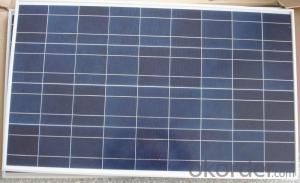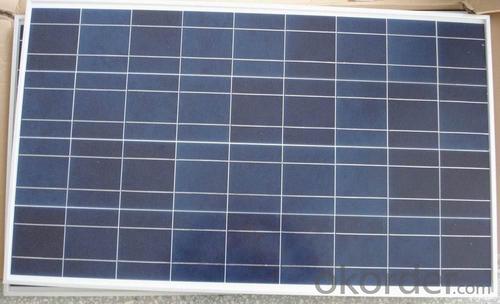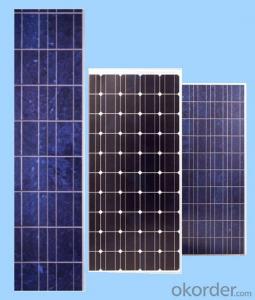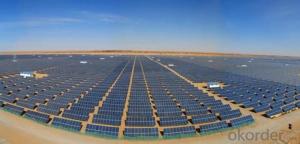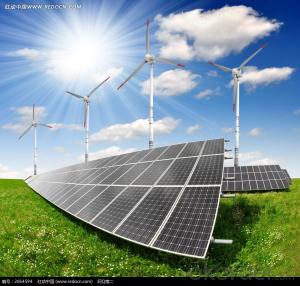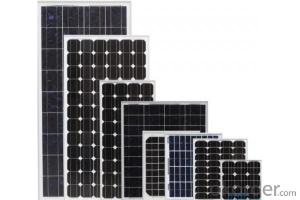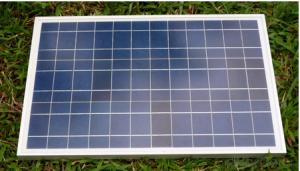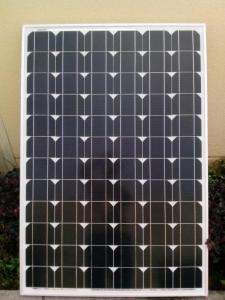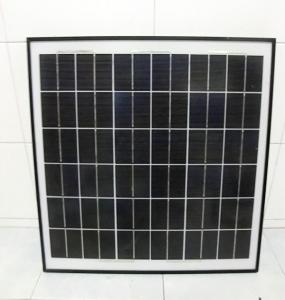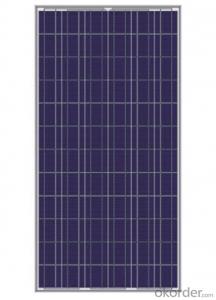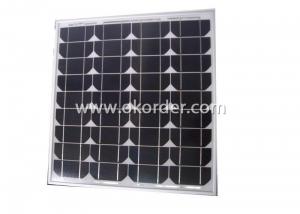Solar Panels Ca - Solar Panel Solar Module PV Solar Grade 250W
- Loading Port:
- Shanghai
- Payment Terms:
- TT OR LC
- Min Order Qty:
- 1 watt
- Supply Capability:
- 10000000 watt/month
OKorder Service Pledge
OKorder Financial Service
You Might Also Like
Specification
Solar panel material
1. glass
Its main role is to protect the power generation ( solar cells ) , there is a selection of light transmittance requirements : 1 ) must be high transmittance (typically 91% or more ) ; 2 ) super white steel processing.
2. EVA
For bonding glass and power generation fixed body ( such as cells ) , transparent EVA material directly affect the life of components exposed to the air EVA prone aging yellow , thus affecting the transmittance components , thus affecting in addition to generating the quality of the components itself, the quality EVA lamination process on the component manufacturers is also very large, such as EVA plastic viscosity of non-compliance , EVA and glass, back bonding strength is not enough, can cause premature aging EVA, the affected component life.
3. Solar cells
The main role is to generate electricity , the electricity is the main market mainstream film crystalline silicon solar cells , thin-film solar cells , both have their advantages and disadvantages . Crystalline silicon solar cells , the equipment costs are relatively low , but the high cost of consumption and cells , photoelectric conversion efficiency is high, the next generation in outdoor sunlight is more appropriate ; higher thin-film solar cells , the relative cost of equipment , but the cost of consumption and battery low, relatively low photoelectric conversion efficiency of crystalline silicon solar cells , but the effect is very good low-light , in the ordinary light can also generate electricity , such as solar calculator .
4. backplane
Sealing, insulation , water ( usually with TPT, TPE , etc. ) the material must be resistant to aging , component manufacturers generally have warranty for 25 years , tempered glass, aluminum is generally no problem , the key lies in whether the backplane and can meet the requirements of silica gel.

PERFORMANCE
- High effi ciency, multicrystalline silicon solar cells with high transmission and textured glass deliver a module effi ciency of up to 16.0%,
minimizing installation costs and maximizing the kWh output of your system per unit area.
- Tight positive power tolerance of 0W to +5W ensures you receive modules at or above nameplate power and contributes to minimizing
module mismatch losses leading to improved system yield.
- Q: I have a playstation PSP charger that is 5v 2A, so it takes 0 watts.I have several small solar panels that put out watt a piece and are 4 volts, 250mAhow can I get my 0 watts to be 5v 2A instead of 4v 250mA? the voltages have to match up right?also, what's a 3-T regulator that controls voltage?
- 3-T is just one type of many devices designed to control voltage so you get the amount you desire with as little static as possible. Without you having an degree in engineering, I can't explain it to you any better. You will also need to produce true sine wave energy or you will burn out your PSP with the correct volts and amps. You need one to produce only 5 volts 2amps. Anything different will burn out yur PSP. Your problem is simple math. Watts = volts multiplied by amps. Amps = Watts divided by volts. So if your solar panels can produce /4 amp ( 250 mA) each, then you connect one to the other in a series until you get enough connected to make 2A. ( 8 panels { /4mA x 8 = 2A}) You now have a panel with 32Volts, 2Amps, 64 Watts. This is where the T-3 regulator comes in. If you buy one for 5 volts, it will allow only 5 volts 2 amps, to go to your PSP.
- Q: Can I add more solar panel let say up to 200 watt and adding two 2 volts battery using the same charges controller and power inverter?
- You can wire solar panels in parallel (i.e. positive to positive, negative to negative). Preferably, the panels should be similar to allow the output voltages to track. Otherwise, it may be necessary to include diodes in series with each panel so voltage variations do not have an adverse effect. The other alternative is to have the panels charging individual batteries and then combining the batteries through diodes before using the inverter. This approach would require separate charge controllers for each battery. Not quite as energy efficient as each diode causes a voltage drop (and so a power loss).
- Q: I am completely ignorant on this subject. I was just wondering out of curiosity of how many solar panels and equipment that it would take to run a central ac for a 2500 sq ft home and a pump for a medium sized pool. I'm talking running ac for like 8 hours a day to keep around 65-70 degrees and running the pump 24/7. Just looking for a general ballpark answer.
- Solar panels are not going to be able to run a pool pump 24/7. They will only produce their rated electricity for 4 to 8 hours a day. For the balance you will need a grid connection or a battery backup. Running the AC would require different power levels depending upon humidity, outside temperature levels, solar gain for the house, and insulation levels. An underground house in Maine will be much easier to AC than a Glass house in Arizona. First find the power requirements. If you had the existing equipment they will have a label with the power requirements or the minimum breaker required if nothing else. For example the pool pump may require a 0 amp 240 breaker while the AC may require a 30 amp 240 breaker. That would be 2400 watts for the pump and (30 x 240) 7200 watts for the AC or a total of 9.6kW each hour of operation. (max) You will next need to find the rated capacity of the solar panels. If each panel were rated at 300 watts then you would need 32 panels for the daytime use and perhaps more to fill in a battery backup. All the numbers are very rough estimates.
- Q: I have a 20 watt solar panel that I want to set up. I need to connect it to the solar controller but do not know what cable to use. I plan on adding more solar panels down the line. What would be the best cable to use?
- 4 awg wire is good for 5 amps and will handle 9 total panels at 2 volts
- Q: if so, would it be possible to make (or remake) an organism that could subsist off of sunlight and external heat like plants?
- There are, in fact, protozoa that use chlorophyll to harvest sunlight, but the thing is, they also MOVE. So it's not entirely unreasonable that an animal cell could do the same.
- Q: I found portable solar panels used for boats etc. and was wondering how I could effectly use them for my home instead. If you have used them in the past, please tell how they worked (good or bad).
- from what i have seen and heard the portable panels you are talking about are not big enough for home use unless you create a specific outlet to use them on such as one for cellphone charger or other small use items. Just my semi-educated guess.
- Q: am having a 75 watts siemens solar panel and is giving me 2.89volts during bright light, i wanted to know can this be used to charge 00Am/hr battery?
- Many of the panels used on homes are designed to produce 2 volts DC. 0 of them wired in a series would produce 20 volts DC. An inverter is used to change the DC voltage to AC. The other aspect of electricity is amperage. With electrical units wired in series the voltage is added. When they are wired in parallel the amperage is added. The Volts x Amps produced will give you the wattage. A wise homeowner will examine their electric bills or the equipment used to determine their demand. They will consult tables that let them know how much sunlight their area receives each year as this will alter the rated performance of the panels. Then they will try and determine how much of the demand they want to fill. 80% may be economical. Then they also want to determine what they will do with excess electricity that may be produced during the summer months of intense sun and how they will supply the shortfall of low sun winter months. From all this they will determine the number of solar panels they need to purchase.
- Q: Can solar panels be installed on agricultural or farming operations?
- Yes, solar panels can be installed on agricultural or farming operations. In fact, many farmers and agricultural businesses are increasingly adopting solar energy as a sustainable and cost-effective solution to power their operations. Solar panels can be mounted on rooftops, open land, or even on barns and sheds, providing clean and renewable energy to offset electricity costs and reduce carbon emissions. Additionally, solar panels can help farmers take advantage of unused or underutilized land, providing dual benefits of energy generation and agricultural productivity.
- Q: Is this a good kit for building a solar panel?
- Only okorder /
- Q: Do solar panels require a backup battery system?
- No, solar panels do not necessarily require a backup battery system. The decision to install a backup battery system depends on individual needs and preferences. While a backup battery system can store excess energy generated by solar panels for later use, it is not mandatory for the functioning of solar panels.
Send your message to us
Solar Panels Ca - Solar Panel Solar Module PV Solar Grade 250W
- Loading Port:
- Shanghai
- Payment Terms:
- TT OR LC
- Min Order Qty:
- 1 watt
- Supply Capability:
- 10000000 watt/month
OKorder Service Pledge
OKorder Financial Service
Similar products
Hot products
Hot Searches
Related keywords
